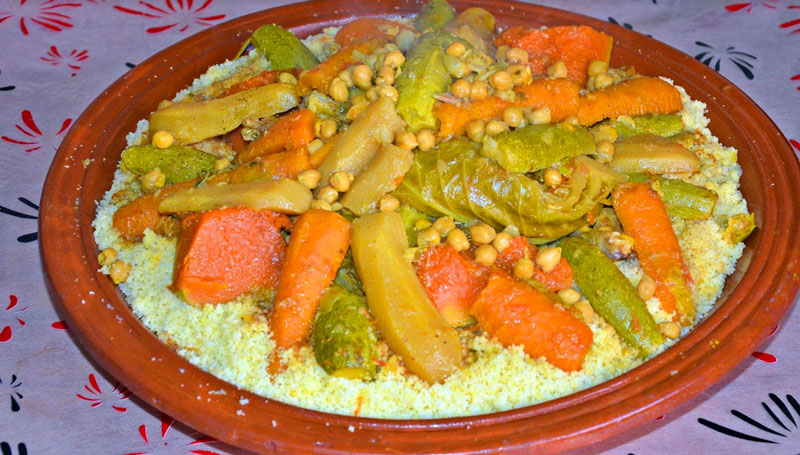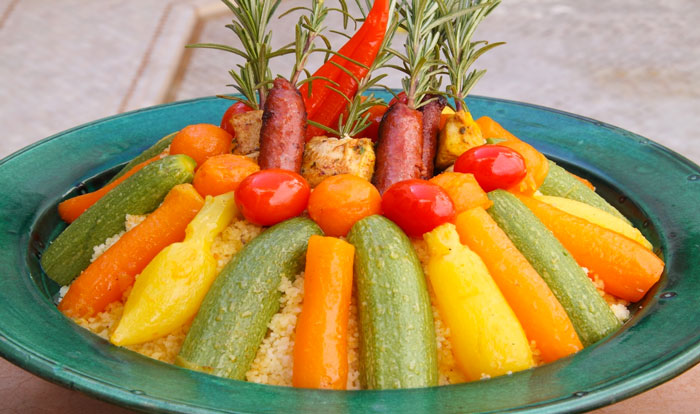Why Moroccan Couscous Is More Than Just a Dish
Why Moroccan Couscous Is More Than Just a Dish
When you think of Moroccan cuisine, one dish instantly stands out, couscous. Far more than just a staple food, Moroccan couscous is a culinary symbol of tradition, community, and comfort. Served in homes and restaurants across the country, couscous brings people together every Friday afternoon, on special occasions, and during festive gatherings. With its fluffy grains, rich spices, and hearty mix of vegetables and meats, this beloved dish is as flavorful as it is meaningful.
But couscous is not just food; it’s a cultural experience. Passed down through generations, the art of making couscous is deeply rooted in Moroccan heritage. Whether steamed patiently in a traditional couscoussier or quickly prepared in modern kitchens, each version tells a story of local flavors and family customs.
In this ultimate guide, you’ll discover everything there is to know about Moroccan couscous, from its ancient origins and regional variations to mouthwatering recipes and where to taste the most authentic versions. Whether you’re a food lover, a curious traveler, or someone planning your next trip to Morocco, this post will inspire you to embrace one of the country’s most iconic dishes.
A Taste of Tradition: History of Couscous in Morocco
The story of couscous stretches back centuries, with its roots firmly planted in the Amazigh (Berber) communities of North Africa. Long before modern Morocco took shape, Berber tribes were crafting couscous by hand using semolina flour, creating a nourishing and versatile base for meals in the harsh climates of the mountains and deserts.
Historians trace couscous back to at least the 11th century, with archaeological findings of ancient couscous makers discovered in Berber settlements. Over time, the dish absorbed the flavors and techniques brought by Arab traders, Andalusian refugees, and later French colonists, evolving into the richly spiced and colorful dish we know today.
In Moroccan households, couscous became more than sustenance; it became a sacred tradition. Prepared on Fridays, Morocco’s holy day of the week, couscous is often shared after communal prayers, symbolizing unity, generosity, and gratitude. Weddings, births, and religious festivals frequently feature large platters of couscous, served family-style to celebrate the occasion.
Despite modern shortcuts and international variations, Morocco has managed to preserve the authenticity of couscous. So much so that in 2020, couscous was officially recognized by UNESCO as part of the Intangible Cultural Heritage of Humanity, cementing its place as a symbol of North African identity.

What Is Moroccan Couscous Made Of?
At first glance, couscous may look simple, but behind its golden, fluffy grains lies a masterful combination of ingredients, technique, and tradition. The heart of Moroccan couscous is semolina, a coarse flour made from durum wheat. When lightly sprinkled with water and rolled by hand, it forms small pellets that are then steamed rather than boiled, giving couscous its signature light and airy texture.
The most authentic Moroccan couscous is steamed in a couscoussier, a two-part pot where the bottom contains a fragrant stew, usually made with lamb, beef, or chicken, and the top holds the couscous, which absorbs the rising aromatic steam. This traditional process may take time, but it results in a perfectly tender grain that’s never sticky or soggy.
The flavors of Moroccan couscous are built layer by layer. It starts with onions, garlic, and olive oil, followed by spices like turmeric, ginger, paprika, cumin, and sometimes saffron or cinnamon, depending on the region. Seasonal vegetables, carrots, zucchini, pumpkin, cabbage, or turnips, are added to the simmering broth, along with legumes like chickpeas for extra depth and nutrition.
While meat is commonly included, vegetarian and vegan versions are just as traditional and delicious. The final touch? A drizzle of tfaya (a sweet mixture of caramelized onions and raisins) or a garnish of roasted almonds for texture and contrast.
This perfect harmony of spice, sweetness, and savory richness is what makes Moroccan couscous not just a dish, but a celebration of flavor and heritage.
Different Types of Moroccan Couscous
While couscous may be Morocco’s national dish, it’s far from being a one-size-fits-all recipe. Across the country’s diverse regions, from the coastal towns to the Atlas Mountains, each type of couscous carries its own flavor profile, preparation style, and cultural context. Here are some of the most beloved and iconic Moroccan couscous varieties:
🟡 Couscous Bidaoui (Casablanca-Style Couscous)
This is the most traditional version served in Moroccan homes every Friday. It typically features lamb or beef, slow-cooked with a medley of vegetables such as carrots, zucchini, pumpkin, cabbage, and chickpeas. The broth is deeply spiced but not overpowering, striking a perfect balance between comfort and complexity.
🟡 Tfaya Couscous
Known for its sweet-and-savory twist, tfaya couscous is topped with caramelized onions, raisins, and cinnamon, and sometimes finished with toasted almonds. The base may include chicken or lamb, but the tfaya topping is what sets this version apart, making it a favorite for festive occasions like weddings and family feasts.
🟡 Seffa Medfouna
This is couscous with a sweet personality. Typically made with steamed couscous or vermicelli, butter, powdered sugar, cinnamon, and crushed almonds, it is often layered over meat (usually chicken) that’s hidden beneath, hence the name “medfouna”, meaning “buried.” It’s served as a dessert-like main dish during celebrations and post-Ramadan meals.
🟡 Vegetarian Couscous
Rich in fresh seasonal vegetables and slow-simmered spices, this meatless version is a popular alternative for those seeking a lighter, plant-based option. It’s just as flavorful, with vegetables soaking up the aromatic broth and sometimes accompanied by chickpeas or lentils.
🟡 Fish Couscous (Couscous with Chermoula)
Popular in Morocco’s coastal cities like Essaouira and Agadir, this variation uses marinated fish, often sardines or white fish, cooked in a chermoula (a spiced herb marinade). The result is a zesty, slightly tangy couscous that reflects the country’s maritime influences.
🟡 Royal Couscous (Couscous Royale)
A true feast on a platter, this dish features a combination of lamb, chicken, and spicy merguez sausages, along with a generous helping of vegetables. It’s typically reserved for large gatherings or special dinners, and its name says it all; it’s a couscous fit for royalty.
How to Make Authentic Moroccan Couscous at Home
Bringing the magic of Moroccan couscous into your own kitchen doesn’t require a trip to the Atlas Mountains, just a little patience, quality ingredients, and respect for tradition. While the steaming technique may seem complex at first, the result is a light, flavorful dish that’s well worth the effort.

Ingredients You’ll Need
To make a classic Moroccan couscous with vegetables and meat, you’ll need:
-
500g medium couscous grains
-
1 kg lamb or chicken (bone-in pieces)
-
2 large carrots
-
2 zucchinis
-
1 piece of pumpkin or squash
-
1 small cabbage
-
1 turnip
-
1 large onion (grated or finely chopped)
-
1 can of chickpeas (or pre-soaked dried)
-
Olive oil, salt, pepper, turmeric, ginger, and saffron (or ras el hanout)
-
Optional: cinnamon, raisins, caramelized onions (for tfaya)
Step-by-Step Cooking Process
- Prepare the Broth
In the base of your couscoussier (or a large pot), heat a few tablespoons of olive oil. Add the meat and brown it with onions and spices. Add water, bring it to a boil, then lower the heat and simmer while adding the vegetables in stages, from firm to softest. - Steam the Couscous (Traditional Method)
Lightly moisten the couscous grains with salted water and rub between your hands to separate. Place it in the top of the couscoussier. Steam for about 20 minutes, then remove and fluff with a fork. Repeat this two or three times, each time rehydrating with a little water and olive oil to keep the grains fluffy. - Final Assembly
Once everything is cooked, place the couscous in a large serving dish. Create a mound, make a shallow well in the center, and ladle the vegetables and meat over the top. Spoon some broth on the sides or serve it separately. Add toppings like tfaya (caramelized onion and raisin) or toasted almonds for a festive finish.
Tips for Perfection
-
Use medium-grain couscous for the most authentic texture.
-
Avoid boiling couscous directly; steaming is key for a light and fluffy result.
-
Always fluff the couscous between steaming stages to prevent clumping.
-
Don’t overload the dish with spices; balance is what defines Moroccan cuisine.
This timeless recipe is a gateway to Moroccan hospitality, perfect for Friday lunches, cozy dinners, or festive occasions. With a little effort, your kitchen will be filled with the same warm aromas found in Moroccan homes from Tangier to Ouarzazate.
What to Serve with Couscous
Moroccan couscous is a complete meal on its own, but what truly elevates the experience is the delicious ensemble of accompaniments that round out the plate. From refreshing drinks to simple side dishes and traditional sweets, here’s how locals enjoy a full couscous spread.
Traditional Side Dishes
-
Khobz (Moroccan Bread): Thick and crusty, Moroccan round bread is often served on the side to soak up the flavorful broth. It’s especially helpful for scooping up couscous the traditional way—with your hands.
-
Harissa or Pickled Vegetables: Some regions serve couscous with a bit of spicy harissa paste, or pickled vegetables like carrots or turnips to add a tangy kick.
-
Raïb (Fermented Milk Yogurt): A cold glass of this mildly tangy drink is commonly served to refresh the palate after the richness of couscous. It’s both a cooling counterbalance and a digestive aid.
Dessert Options After Couscous
-
Orange Slices with Cinnamon and Orange Blossom Water: A light, fragrant dessert that’s both refreshing and symbolic of Moroccan hospitality.
-
Seasonal Fresh Fruits: Depending on the season, locals often serve grapes, pomegranates, or melon to cleanse the palate.
-
Moroccan Pastries: For special occasions, couscous might be followed by gazelle horns (kaab el ghazal) or chebakia, sweet sesame-coated pastries served especially during Ramadan or family celebrations.
Beverages That Pair Well
-
Mint Tea: No Moroccan meal is complete without a glass of sweet and aromatic Atay B’Naana (mint tea). It helps with digestion and brings a ceremonial close to the meal.
-
Fresh Lemon Juice or Almond Milk: During hot days or festive meals, locals might serve cold almond milk (lben) or freshly squeezed lemon juice.
Whether you’re sharing a meal with family, guests, or simply treating yourself to a flavorful dish, pairing couscous with the right sides and drinks transforms it into a celebration of Moroccan culture.
Couscous on Fridays: A Weekly Ritual
In Morocco, Friday isn’t just the day before the weekend; it’s a sacred moment of gathering, reflection, and generosity, and no Friday is truly complete without a steaming platter of couscous at the heart of the table.
Rooted in both religious and cultural traditions, the Friday couscous meal—often served after the Jumu’ah (Friday prayer)—is a cherished weekly ritual in Moroccan homes. Families, neighbors, and even strangers are invited to share this symbolic dish, which represents baraka (blessing), unity, and gratitude.
What makes the Friday version of couscous special is its carefully prepared simplicity. While it often includes lamb or beef, many Moroccan families focus on vegetables and legumes, reflecting values of modesty and sharing. The couscous is steamed to perfection and served in a large communal dish, encouraging everyone to eat together, traditionally using the right hand or a spoon.
In rural areas, the Friday couscous often takes on a communal character, with women in the neighborhood preparing large batches and delivering portions to mosques, neighbors, or those in need. This act of sharing, known as “zakat” or “sadaqa”, is both a religious duty and a heartfelt expression of Moroccan generosity.
Even in modern urban homes, this tradition endures. Offices may close early, restaurants fill with the aroma of spices, and markets bustle with people buying vegetables and fresh meat, all for couscous.
Where to Try the Best Couscous in Morocco
If you’re visiting Morocco, tasting authentic couscous isn’t just a recommendation; it’s a must-have culinary experience. While you can find couscous almost anywhere in the country, certain cities and establishments elevate it to an art form, combining traditional recipes with warm hospitality and regional flair.
Marrakech: Rooftop Riads and Traditional Friday Meals
In the heart of the Medina, many riads and family-run restaurants serve homemade couscous on Fridays, offering a truly local experience. Try places like Café des Épices or La Maison Arabe for flavorful couscous in a charming setting. Cooking classes in Marrakech often include couscous as a main dish, an excellent opportunity to learn the secrets firsthand.
Fes: A Spiritual and Culinary Capital
Fes is known for its deep-rooted culinary heritage. Here, couscous is often prepared with 20+ spices and slow-cooked meats. Local spots such as The Ruined Garden and Dar Hatim serve rich, traditional versions. The medina is also home to some of the oldest couscous-making traditions in the country.
Essaouira: Seafood Couscous by the Coast
In this relaxed coastal town, couscous takes on a unique twist, served with grilled fish or sardines marinated in chermoula. Local seafood restaurants like Chez Sam or La Licorne offer fresh and flavorful seafood couscous paired with ocean views.
Atlas Mountains & Berber Villages
To taste couscous at its most authentic, head into the mountains. Many Amazigh families offer meals to hikers and travelers. Their couscous is earthy, rustic, and always cooked with love. This is also where you’ll find the more vegetable-forward and hearty variations, steamed slowly over a wood fire.
Casablanca: Where Classic Meets Creative
As Morocco’s cosmopolitan hub, Casablanca blends tradition with innovation. High-end restaurants like La Sqala and Rick’s Café serve Royal Couscous with lamb, chicken, and merguez. You can also find street vendors offering affordable, home-style couscous packed with local flavor.
From mountain villages to coastal cities, couscous is the thread that connects Morocco’s diverse regions and culinary identities. Whether you enjoy it with lamb, fish, or caramelized onions, you’re tasting a piece of Moroccan history in every bite.
Couscous Beyond Borders: Global Popularity
Moroccan couscous has traveled far beyond the dunes of the Sahara and the souks of Marrakech, becoming a beloved dish in kitchens around the world. From Parisian bistros to Los Angeles health cafés, couscous has earned its place as both a comfort food and a culinary trendsetter.
In France, couscous is one of the most popular dishes, often ranking among the top favorites in national food surveys. This popularity stems from the long-standing connection between France and North Africa, where generations of Moroccan and Algerian immigrants brought their culinary traditions with them. Today, couscous is a staple in many French homes and is often found in restaurants offering Maghrebi cuisine.
Beyond Europe, Moroccan couscous has gained traction as a healthy, plant-based option in North America, Australia, and the Middle East. Its versatility makes it ideal for modern diets, rich in fiber, naturally low in fat, and easy to combine with vegetables, legumes, or lean proteins. Supermarkets now carry pre-steamed couscous and instant versions, allowing more people to prepare it conveniently at home.
Couscous has also been adopted by celebrity chefs and food influencers, who often reinterpret it in fusion cuisine, pairing it with roasted vegetables, grilled halloumi, or spicy tofu for creative new takes. Still, even as couscous evolves in modern kitchens, its Moroccan soul remains unmistakable: nourishing, communal, and full of flavor.
In 2020, couscous received global recognition when UNESCO inscribed it on the Intangible Cultural Heritage list, acknowledging the importance of this humble grain in the cultural life of Morocco and the Maghreb region.
Whether served in a family courtyard in Fes or on a dinner table in New York, couscous continues to unite people through shared tradition, good food, and timeless taste.
Fun Facts and Couscous Culture
Behind every fluffy grain of couscous lies centuries of tradition, symbolism, and even a few surprising facts. Whether you’re discovering it for the first time or grew up with couscous on your family table, these cultural insights and curiosities will deepen your appreciation for Morocco’s most iconic dish.
1. UNESCO Recognition
In 2020, Moroccan couscous (along with Algeria, Tunisia, and Mauritania) was officially added to UNESCO’s Intangible Cultural Heritage list. This global recognition highlights couscous as a living tradition, passed down through generations, connecting communities, and reinforcing identity.
2. A Dish with Superstitions
In some parts of Morocco, couscous is believed to bring blessings and ward off bad luck. That’s why it’s often the first meal served to guests in a new home, after childbirth, or during spiritual ceremonies. Some families even sprinkle couscous at the doorway as a gesture of protection.
3. A Symbol of Peace and Sharing
Couscous is traditionally served from one large communal dish, emphasizing unity, equality, and togetherness. Eating from the same plate, each person taking from their own section, is a symbol of respect and shared fortune.
4. No Forks Needed
In many Moroccan homes, couscous is eaten by hand, using only the right hand to form small balls and pop them into the mouth. This practice is part of Moroccan etiquette and reflects the deep connection between food and physical presence.
5. It’s More Than Just Food, It’s an Heirloom
Many Moroccan women learn to prepare couscous from their mothers or grandmothers, who teach them not only the recipe, but also the rhythm and feel of hand-rolling semolina, the timing of steaming, and the way to layer flavors with care.
These small details, some spiritual, some practical, show how couscous is woven into the very fabric of Moroccan life. It’s a dish that nourishes both body and soul, preserving a sense of identity while continuing to evolve across generations and borders.
